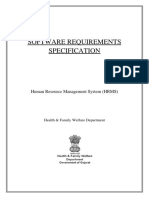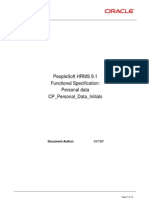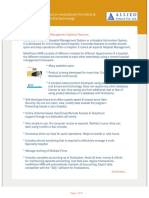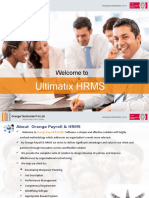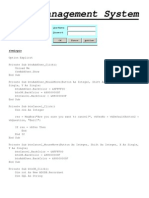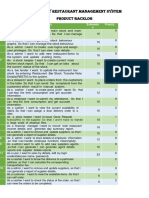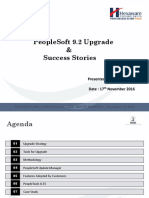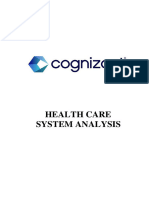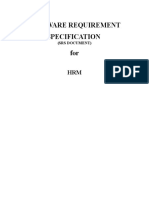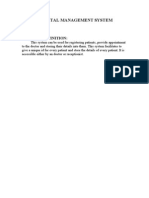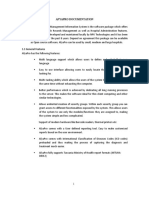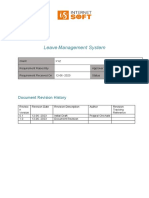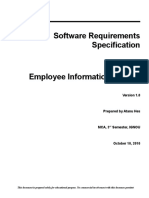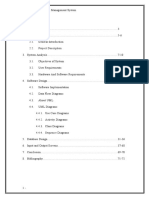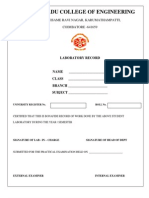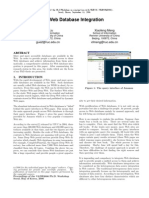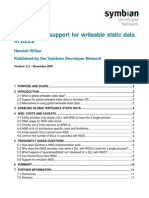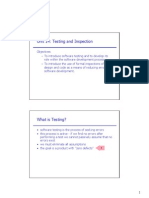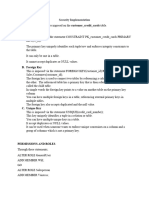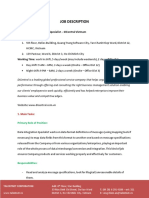Employee Management System
Technical Story Card
Revision History
Version Date Prepared by / Significant Changes
No. Modified by
1 08-02-2022 CH. Pawan Introduction and Scope of Change
Kumar
2 22-02-2022 CH. Pawan Process model
Kumar
3 12-03-2022 D. Kavitha Er diagram ,sequence diagram
4 13-03-2022 D. Kavitha Use case diagram
5. 23-03-2022 CH. Pawan Scope of change,Reference
Kumar
6. 24-03-2022 D. Kavitha Process user interface diagram
7. 24-03-2022 D. Kavitha Process model
2
� Glossary
Abbreviation Description
BSC Business Story Card
TSC Technical Story Card
DOJ Date Of Joining
3
� Table of Contents
1 Introduction…………………………………………………………………...........................................5
2 Scope of Change............................................................................................................................. 5
3 List of impacted modules............................................................................................................... 6
3.1 use case module...........................................................................................................................6
4 Design and Detailed technical updates......................................................................................... 6
4.1 Process model....................................................................................................................... 6
4.1.2 Architecture diagram……………………………………………………………………………..7
4.1.3 Class diagram…………………………………………………………………………………......9
4.1.4 Sequence diagram............................................................................................................10
4.2 Proposed user Interface design.........................................................................................12
4.3 Database design changes.................................................................................................. 21
4.3.1 ER Diagram……………………………………………………………………………………….21
5 References..................................................................................................................................... 21
4
� 1 Introduction
This software application stores all the employee's information in a database. It is
an application developed in Java and the database used is SQL. It contains employee
information like employee id, name, date of joining, and basic pay.
It is an easy-to-use application and has a user-friendly interface. It is totally built at
the administrative end which means that only the admin has access rights to change or
modify any records. So, this makes it a safe and reliable application to use.
The main aim of developing this application was to reduce the errors that occur in
the manual system. One can search the details easily by just entering an employee id.
In earlier systems, there was not such a facility to do so. All the details are stored in an
SQL database. It is easy to update any employee details. All the employee records are
integrated and so this makes it a user-friendly and easy to use application.
2 Scope of Change
We can add registration for new Employee. When new employee fill the registration
details and it go to login page. once employee enter to login details ,it will go to home
page. Then employee can able to enter the details like ID, D.O.J and basic pay .It
shows the overall salary details TAX,DA,HRA,GROSS,NET.
5
� 3 List of impacted modules
3.1.1 Use Case Model:
4 Design and Detailed technical updates
4.1 Process model
Process models are processes of the same nature that are classified together
into a model. It track what actually happens during a process Take the point of view of
an external observer who looks at the way a process has been performed and
determines the improvements that must be made to make it perform more effectively or
efficiently.
6
� 4.1.2 Architecture Diagram:
Layer Logical View Technology/
Framework
UI Components
Login Find All Emp
Home Create New Emp
HTML-5/ CSS/
Presentation Delete Emp By Id Edit Emp By Id JavaScript 4.5.5/
Layer Angular-8
Find Emp By Id Log Out
Web-Server Classes
Application/ Configuration Controllers Java 1.8/ Spring
Business Boot-2.3.3/Sprin
Layer Service REST Controllers g Data JPA
Entity/ Model Classes
Repository classes
Data Access
Layer
Spring Data JPA
Oracle 11G
Database
7
�4.1.2.1 Presentation Layer:
This layer consists of all UI components.
Login Component: Employee can use the login component to login to their
respective accounts.
Create New Employee Component: Employee can add the details emp name,
date of joining, basic pay and click add employee
Find Employee By Id Component: Employee search Id and click show details
Get all Employee Details
Find All Employee Component: Get the employee details it display ID, Name,
D.O.J, Basic Pay, DA, HRA, Gross, Tax, Net.
Delete Employee By Id Component: Give employee Id click Delete button then
Delete the employee details
Edit Employee By Id Component: We can give employee Id click edit button it
show the edit page .We can edit the details.
Log Out Component: When I click Log Out button it go to Log Out user
4.1.2.2 Application Layer:
This layer comprises of all server and business classes.
Configuration settings (XML or Class based) will define the application and
server configuration.
Spring Controllers defines the server classes, which are required to process the
incoming http requests.
Service classes are required to perform the required business services.
REST Controllers to process the HTTP AJAX requests.
Model classes are used to define the functions of the entities present in the
system.
4.1.2.3 Data Asses Layer:
Data layer is implemented through Hibernate ORM. It will contain the repository classes,
which provides interface to the table.
4.1.3 Class diagram
8
�9
�4.1.3 Sequence diagram
10
� 4.2 Proposed user Interface design
Registration Page:
Brief Description Registration
Basic Flow This use case describes how an Employee gets into User Profile
page
1. The client has to register himself into the system.
2. The following information is required to Registration.
First Name
Last Name
Email Id
Phone No
Password
Conform Password
Address
Alternate Flow 1. 1.The system will validate the credentials provided.
Validation 1. Valid Username
2. Valid Employee ID
3. Password is similar as Conform Password
Pre-Conditions User should have network access and Browser with latest updates.
Post-Conditions Landing page has to be displayed.
11
�Log In page:
Brief Description Login
Basic Flow This use case describes how an Employee gets into User Profile
page
3. The client has to register himself into the system.
4. After the successful login, user will be taken to the
appropriate landing page.
5. The following information is required to login.
Employee name
Employee ID
Alternate Flow 2. The system will validate the credentials provided. If
credentials are invalid, login form will be redirected again
with error message.
Validation 4. Valid Username
5. Valid Employee ID
Pre-Conditions User should have network access and Browser with latest updates.
Post-Conditions Landing page has to be displayed.
Create New Employee:
Brief Description Create New Employee
Basic Flow This use case describes how a Employee profile in to the system
1.The Employee should add the details in the form.
2.The following information is required during Add an
12
� Employee.
Enter Emp Name
Enter Date of Joining
Enter Basic pay
Alternate Flow 1.The system will validate the credentials provided.
Validation 1.Name is required and minimum 3 characters and max 30
characters.
2.Employee can be alphanumeric.
3.City should be valid
4.The Date of joining should be selected from a drop-down.
Pre-Conditions 1.User should have network access and Browser with latest
updates.
Post-Conditions 1.Success message should be shown I employee add .
Find Employee By Id:
Brief Description Find Employee By Id
Basic Flow This use case describes how Employee profile in to the system
1. The Employee should enter Id in the form.
2. The following information is required during Add an
Employee.
Enter Employee Id
13
�Alternate Flow 1. The system will validate the credentials provided.
Validation
1. The Employee Id should be selected from a drop-down.
2. The Id entered should be in integer datatype.
Pre-Conditions 1. User should have network access and Browser with latest
updates.
Post-Conditions 1. Success message should be shown I employee details .
14
� Get All Employee:
Brief Description Get All Employee
Basic Flow 1.This use case describes how an Employee profile in to the system
2.The Employee should enter the Get all Employee in the form.
Alternate Flow 1.The system will validate the credentials provided.
Validation 1.The Get All Employee entered should be in String datatype.
Pre-Conditions 1.User should have network access and Browser with latest updates.
Post-Conditions 1.Success message should be shown All employees details .
15
�Edit Employee By Id:
Brief Description Edit Employee By Id
Basic Flow This use case describes how a Employee profile in to the system
1.The Employee should edit the details in the form.
2.The following information is required during Edit Employee
by ID.
Edit Employee Name
Edit Employee id
Edit Date of Joining
Edit Basic pay
16
�Alternate Flow 1.The system will validate the credentials provided.
Validation 1.Name is required and minimum 3 characters and max 30
characters.
2.Employee Id can be alphanumeric.
3.Edit basic pay
4.The Date of joining should be selected from a drop-down.
Pre-Conditions 1.User should have network access and Browser with latest
updates.
Post-Conditions 1.Success message should be shown I employee add .
17
�Delete Employee By Id:
Brief Description Delete Employee By Id
Basic Flow This use case describes how a Employee profile in to the system
1.The Employee should enter the Id in the form.
2.The following information is required during Add an
Employee.
Enter Employee Id
Alternate Flow 1.The system will validate the credentials provided.
Validation
1.The Employee Id should be selected from a drop-down.
2.The Id entered should be in integer datatype.
18
�Pre-Conditions 1.User should have network access and Browser with latest
updates.
Post-Conditions 1.Success message should be shown I employee details .
19
�20
� 4.3 Database design changes
4.3.1 ER Diagram
5 References
We as a team have used references to LMS to complete our project of “Employee
Management System”. HCL provide the three months training for us on that particular
training we learn so many technologies like core java , hibernate ,spring boot, HTML,
CSS, angular .Whatever we learn in that training we implement our project.
21









